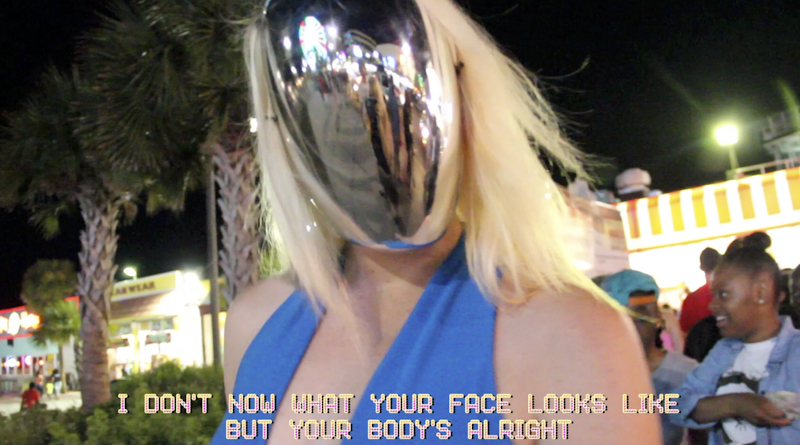Signe Pierce and Alli Coates’ American Reflexxx (2013) has been the subject of an article on The Devi, which investigates its continuing importance over 5 years later.
Signe Pierce: A Fierce Female Multimedia Artist You Need To Know About
By Stefanie Regina Dietzel
Of Cyborgs, Sexualisation, and Aggression against the Unknown
Imagine being on holiday. You’re walking down a crowded boulevard by the beach. You see a person with long blonde hair. They’re wearing a blue skintight dress, and a silver mask that covers their face. What do you do?
1. You ask them to have sex with you. (With the mask on, of course!)
2. You yell “It’s a SHIM!”, and make other assumptions about their gender.
3. You try to rip the mask off because you really can’t stand not knowing their gender.
4. You push them so they fall to the ground.
Who the hell came up with the first four options!?
If you chose number five, you may be shocked to hear that none of the other answers were made up. These are exactly what happened during a one hour performance by Signe Pierce back in 2013, American Reflexxx; a work that’s still relevant today.
Signe Pierce (born 1988)
New York based artist Signe Pierce defines herself as a “Reality Artist”, using reality as her canvas. In her work she poses questions regarding gender, identity, and sexuality. For her performances, she deliberately adapted patriarchal beauty ideals – she lost weight, dyed her hair platinum blonde, and surrounded herself with all things pink. The self-appointed “Cyborg Barbie” wanted to infiltrate the idea of femininity – by becoming it. She wanted to make art that oozed conventional femininity, and in doing so: challenge our idea of it.
American Reflexxx
American Reflexxx was filmed by Alli Coates, Pierce’s partner at that time. The fully unscripted video started as a social experiment: Pierce would walk around the neon-lit promenades of Myrtle Beach, South Carolina; wearing high heels, a blue dress, and a silver mask. Through the duration of one hour, the piece is documenting harmful attitudes towards gender and sexuality – see answers one through four for examples. Pierce stayed silent for the duration of the performance. This is an extreme case of the artist using her body for her work, calling attention to the ways the female body is objectified.
With Pierce being so much at the mercy of the crowd, it is reminiscent of performances like Marina Abramović’s Rhythm 0 or Yoko Ono’s Cut Piece.
Availability of the Female Body
Sexualised bodies, especially female, are all around us in the media. They seem available, always there to view, judge and enjoy. The shocking confidence with which one man declares his plans to sleep with Pierce during her performance shows how the lines between that availability in the media and real life are blurred. The mask provides some kind of anonymity: the face behind the mask doesn’t matter so much to the observer as the body attached to it. This degrades Pierce to a mere object.
Later in the video, a woman pushes Pierce so hard that she falls to the ground; her knee bleeding. The initial intention behind American Reflexxx was to film something “pretty”, while taking the “cyborg” from digital into the real world. Even though the artist duo had anticipated a few catcalls, or perhaps some light crowd interaction, this angry mob mentality came most unexpectedly.
Fear of the Unknown
It was not only Pierce’s body that provoked the masses. The mask that fully covered her face seemed to become an issue of its own. People didn’t know what to make of such a person. Were they a man, a woman, someone with a trans identity? Was that person ugly or pretty? They were eager to find out, as if knowing would give them more or less justification to exercise hostile behaviour. Confusion so easily turns into hate.
Yet the artist knew that she would not give them the satisfaction of revealing her face. For her, they didn’t have the right to demand so, nor did they deserve to be relieved of their fears for the unknown. The fear of not knowing what might be hidden under that mask, or to make a very current real-world comparison, that headscarf.
Embracing Diversity
The film itself is only the first part of the project – the reactions to the video posted online the second. Commenters weren’t holding back their anger towards Pierce’s aggressors, and even wished violence upon them. But this wasn’t the reaction the artists wanted to evoke. They hoped for a greater sense of courage and community, of standing up for those treated badly for being who they are. Being fearless in voicing your convictions against injustice is how change happens. It’s not about ignoring the dangers the video demonstrated, but more about creating awareness. Pieces such as Pierce’s performance help to spark a dialogue extending beyond the perimeters of the art world.
Signe Pierce received her BFA from the School of Visual Arts in 2011. Pierce debuted at Annka Kultys Gallery in 2017 with “Faux Realities”, an exhibition of 30 photos that questioned the nature of truth and artifice within the digital image.
Her video work and performances have been shown at MoMA, New York (2019); MdbK, Leipzig, Germany (2018); Athens Biennial, Greece (2018); Düsseldorf Photo, Germany (2018); the Palais de Tokyo in Paris (2015); Museum of Contemporary Art, Los Angeles (2014); and the New Museum, New York (2014). Despite all the implied critique about social media in her work, she is sharing her art across her online platforms to make it accessible to a wider audience beyond those who would typically visit galleries.


